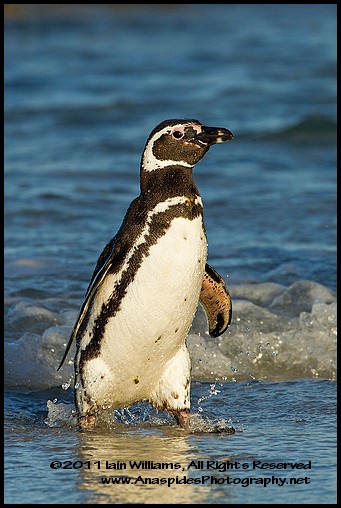Magellanic Penguins (Spheniscus magellanicus), Falkland Islands
 Friday, June 10, 2011 at 5:45PM
Friday, June 10, 2011 at 5:45PM  Magellanic Penguins
Magellanic Penguins
Magellanic penguins (Spheniscus magellanicus) are widespread in the Falklands and I found them on every island I visited. Unlike the other penguins in the Falklands, magellanics live in burrows. They are very shy and photographing them is not easy as they are apt to scarper quickly into their burrows if approached too closely. However, you can get quite close to them if you maintain a low profile, avoid eye contact and approach them very slowly and carefully.
Although the magellanics form large breeding colonies intersected by underground tunnels, many breed away from the colony either solitarily or in small groups. During the breeding season the penguins collect leaves or other vegetation to line the confines of their burrows constructed in the peat or sand.
Two eggs are laid deep within the burrow and incubation lasts 39–42 days, a task which the parents share in 10-15 day shifts. The chicks are cared for by both parents for 29 days and are fed every two to three days. Normally, both are raised through adulthood, though occasionally only one chick is raised. Magellanics are monogamous and the male returns to the same burrow every year to re-connect with his female partner.
LEFT: Just before dusk a Magellanic comes ashore
Magellanics construct their burrows wherever the earth is soft. As such, it's not uncommon to find burrows in the sand dunes and in the peat bogs. Those penguins that move into the peat bog seemingly take on the appearance of the bog and their white chests are quickly covered in mud.
T he penguins feed on a variety of seafood including: crustaceans, krill, sardines and squid. Although this species is not endangered, climate change is affecting their food source
he penguins feed on a variety of seafood including: crustaceans, krill, sardines and squid. Although this species is not endangered, climate change is affecting their food source
Penguins Stop Military Landing
During the Falklands War in 1982, the British decided not to launch an amphibious attach on one of the beaches that was occupied by magellanic penguins, as they were concerned that their vehicles and soldiers would become “bogged down” in the many deep burrows and tunnels that these penguins construct.
LEFT: A magellanic Penguin stands outside its burrow with flippers outstretched warming itself in the morning light. The burrow is cconstructed within peaty soil.
If your keen on penguins and want to see more images of these delightful creatures, navigate to either my FlickR page or web gallery page.
In my next post we'll have a look at the most outrageous of all penguins - the rockhopper! Then we'll change tact and examine one of the most majestic birds found in the Falklands, the black-browed albatross.



Reader Comments (1)
Hi Ian, Wonderful penguins - I just love them.
You really put some time into this blog and it shows. Keep it up as I really enjoy reading about your trips,s seeing the pictures and learning about the animals.